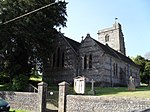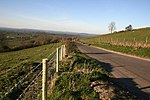Winterborne Houghton

Winterborne Houghton is a village and civil parish in north Dorset, England. It is situated in a winterbourne valley on the Dorset Downs, five miles (eight kilometres) southwest of Blandford Forum. In the 2011 census the parish had 82 households and a population of 183. In 2001 the population was 195.The name "Winterborne" derives from the River Winterborne, which has its source here. The river only flows overground during the winter, hence the name. To the east is Winterborne Stickland and the river flows on to this village, eventually joining the River Stour. To the southwest is Milton Abbas.Residents of Winterborne Houghton used to be known as "Houghton Owls", in reference to the story of a villager who, when calling for help having got lost in the woods, mistook the calls of owls for answering human voices. In his book Dorset Villages Roland Gant posits the theory that Thomas Hardy used this tale as inspiration for the scene where Joseph Poorgrass gets lost in Yalbury Wood in Far from the Madding Crowd.
Excerpt from the Wikipedia article Winterborne Houghton (License: CC BY-SA 3.0, Authors, Images).Winterborne Houghton
Water Lane,
Geographical coordinates (GPS) Address Nearby Places Show on map
Geographical coordinates (GPS)
| Latitude | Longitude |
|---|---|
| N 50.8394 ° | E -2.2571 ° |
Address
Winterborne Houghton
Water Lane
DT11 0PE , Winterborne Houghton
England, United Kingdom
Open on Google Maps








